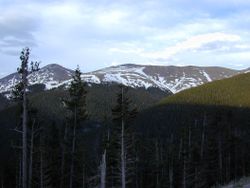
Back خط الشجر Arabic Meşə sərhədləri Azerbaijani Mediu lėnėjė BAT-SMG Límit arbori Catalan Hranice lesa Czech Trægrænse Danish Wald- und Baumgrenze German Tree line English Arbarlimo Esperanto Límite del bosque Spanish

The tree-line or timberline is the edge of the habitat at which trees can grow. Beyond the tree-line, they are unable to grow as conditions are too bad.
There are several types of tree lines defined in ecology and geology:
- Arctic tree-line The farthest north in the Northern Hemisphere that trees can grow; farther north, it is too cold.
- Antarctic tree-line The farthest south in the Southern Hemisphere that trees can grow; farther south, it is too cold as well.
- Alpine tree-line The highest height where trees grow: higher up, it is too cold, or snow covers the ground for too much of the year. The climate above the tree-line is called an alpine climate.
- Exposure tree-line On coasts and isolated mountains, the tree-line is often much lower than in corresponding altitudes inland and in larger, more complex mountain systems, because of strong winds reduce tree growth.
- Desert tree-line The places where trees cannot grow as there is too little rainfall.
- Toxic tree-line The environment is too extreme for trees to grow. This can be caused by molten lava or hot rock (infrared radiation), any of several kinds of fumarole (steam, sulfur, acid), soil pH, low oxygen conditions, salt concentrations (as near the Dead Sea or Great Salt Lake), sulfate levels, other natural causes, or by man made pollution.
- Wetland tree-line The wettest ground on the margins of muskegs and bogs that trees can grow in, below which the ground is too saturated with water, excluding oxygen from the soil that tree roots need to grow. However, no such line exists for swamps, where trees, such as Bald cypress and the many mangrove species, are adapted to growing in permanently waterlogged soil.

At the tree line, tree growth is often not clear with the last trees forming low bushes. If it is caused by wind, these are known as krummholz, from the German for 'twisted wood'.
The tree line, like many other natural lines (lake boundaries, for example), appears well-defined from a distance, but upon close inspection, it is not that clear. Trees grow shorter until they simply stop growing.